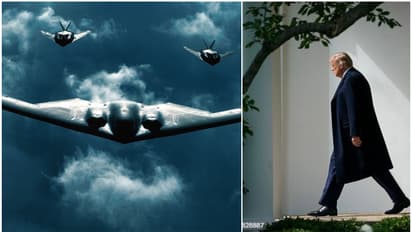Israel-Iran conflict: Why did the US bomb Iran's nuclear sites? What were the targets and how was it done?

Synopsis
The United States bombed Iran’s top nuclear sites, namely Fordow, Natanz and Isfahan, using B-2 stealth bombers and bunker buster bombs. US President Trump confirmed the strikes, calling them successful and aimed at peace.
On Sunday morning, US President Donald Trump announced that the United States had carried out precision airstrikes on Fordow, Natanz and Isfahan, the three major Iranian nuclear facilities.
The strikes were carried out by B-2 Spirit stealth bombers, which dropped Massive Ordnance Penetrator (MOP) bombs on deep underground facilities. Trump posted on Truth Social, confirming:
“A full payload of BOMBS was dropped on the primary site, Fordow… There is not another military in the World that could have done this. NOW IS THE TIME FOR PEACE!”
The attack on Iran marked the first direct US military strike on Iran in over four decades.
What was targeted and why
1. Natanz Nuclear Site
Located about 220 km southeast of Tehran, Natanz is the heart of Iran's uranium enrichment program. Iran had enriched uranium here up to 60% purity, close to weapons-grade.
Above-ground structures had already been damaged by earlier Israeli strikes. The latest US attack focused on underground centrifuges and power lines were cut to disable operations, report agencies.
The International Atomic Energy Agency (IAEA) confirmed that radioactive materials did not leak beyond the site.
Fordow Enrichment Facility
About 100 km southwest of Tehran, Fordow is built deep inside a mountain, making it extremely difficult to destroy. The US used 30,000-pound GBU-57 bunker buster bombs to strike it. Only B-2 bombers can carry these bombs, proving direct US involvement was essential.
A US official confirmed that Fordow has been 'taken off the table' after the strike and Trump also posted on social media platform Truth Social, 'Fordow is gone'.
Isfahan Nuclear Center
Isfahan is located around 350 km southeast of Tehran. It reportedly houses three Chinese-supplied reactors, laboratories and a uranium conversion plant.
While Israel had targeted parts of it earlier, the US strike focused on disabling its fuel production capability.
The IAEA had confirmed that radiation levels remained normal.
What sites were not targeted?
Some nuclear facilities in Iran were left untouched:
- Bushehr Nuclear Power Plant, used for civilian energy and fueled by Russia.
- Arak Heavy Water Reactor, once capable of plutonium production, but redesigned under the 2015 nuclear deal.
US did not strike the nuclear site. IDF on June 19 posted on X that an inactive nuclear bomb site on Arak was neutralized.
- Tehran Research Reactor, which now uses low-enriched uranium for peaceful purposes.
These sites are still under IAEA monitoring and were not part of the military action.
Why did the US use B-2 stealth bombers?
The B-2 Spirit, built by Northrop Grumman, is one of the world’s most advanced bombers:
- Stealth design helps it avoid radar detection.
- Can carry 40,000 pounds of weapons, including two MOP bunker busters.
- Costs around $2.1 billion per unit.
- Has a range of over 6,000 nautical miles without refuelling.
The aircraft took off from Whiteman Air Force Base in Missouri. The mission included refueling mid-air using KC-135 tankers. The entire operation lasted over 40 hours.
Did the US use other weapons too?
Yes. According to reports, 30 Tomahawk cruise missiles were fired from submarines positioned about 400 miles offshore. The aim was to hit hardened underground targets and avoid civilian casualties.
All planes and personnel involved returned safely.
How did the world find out?
US President Donald Trump kept the operation completely secret. He had returned to the White House from New Jersey quietly, just hours before the strike, for a high-level national security briefing.
Even news channels were reporting he was 'weighing options' while bombers were already en route.
Later, in a televised address, Trump called the attack a success and said, 'Now is the time for peace.'
What happens next?
While Trump made clear that the US is not aiming for regime change, US military forces remain on high alert:
- The USS Carl Vinson is in the Arabian Sea
- The USS Nimitz is heading toward the region
- Missile-defense destroyers have been placed across the Mediterranean
Though Trump rejected plans to target Iran’s Supreme Leader Ayatollah Ali Khamenei tensions remain high. Iran’s response will decide whether the region moves toward diplomacy or deeper war.
Why does Iran’s nuclear program matter?
Iran began its nuclear journey in 1957 with US help under the Shah. After the 1979 Islamic Revolution, ties with the US broke.
Though Iran signed the Nuclear Non-Proliferation Treaty (NPT), many countries believe it is secretly working toward nuclear weapons. This week’s strike is the most serious military step taken by the US to stop Iran’s nuclear progress.